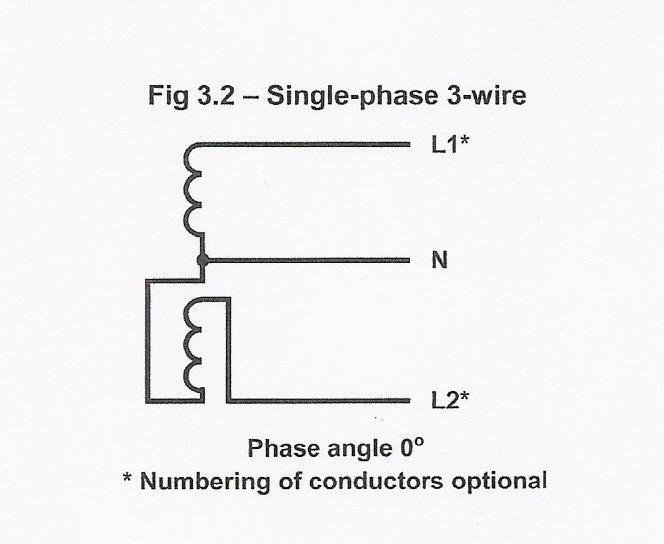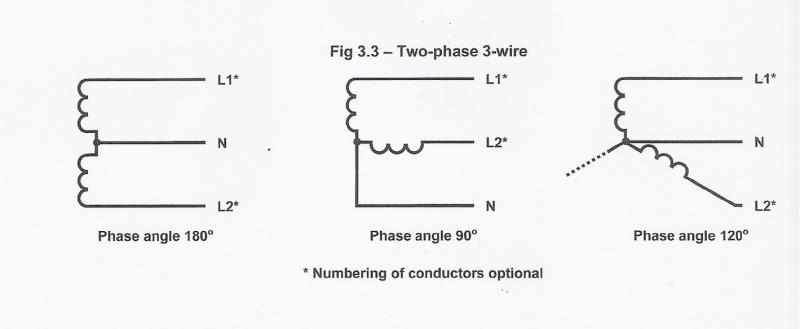It doesn't necessarily mean right either. Besides, whichever you think is right, it can't be both one phase and two. If the committee coming up with this nonsense is sure that it's right now by calling it 2 phases, then it must be saying that it's been wrong all these years by calling it 1 phase before.
Are you forgetting the "3-wire" part of the definition?
And before this apparent sudden change, what did you call it? Single phase or two phase?
I called it split phase.
But I have no problem with there being two different names for the same thing.
Just because you see it moving toward you then away from you from your vantage point halfway up the hill doesn't change that.
I wonder if the problem is that the words have never been big enough.
I'll try making them even bigger this time, then perhaps you will see them.
It has changed direction
And that does not make the currents out of phase. At ANY point on a conductor the current at any moment must be flowing towards that point from one side and away from it on the other.
And therefore if you expose that point and make it available, and use it as the reference point from which you start to measure and refer to all the other points you expose currents going in opposite directions relative to that point.
But if you see that car coming towards you from the north, passing you, then going away from you to the south, it is travelling north to south.
Not from my perspective. It is travelling towards me and then it is travelling away from me.
It's travelling north to south when it's approaching you and it's travelling north to south when it's going away from you. It hasn't changed direction, it's been going in one direction the whole time.
OK - imagine I was standing exactly on the North Pole, and across a flat expanse of ice comes the car, travelling in what any external observer would say is a straight line, it passes me, and continues in, to the external observer, a perfectly straight line.
I would say it has changed direction, from towards me to away from me.
And you too are now going to have to say it has changed direction, from travelling north to travelling south.
How can that be, I wonder?
Have there been two changes of direction of the vehicle then, from towards/towards, to towards/away, to away/away?
There has been one change of direction per observer.
Back at the North Pole, we now have three observers, and two changes of direction observed between them.
Myself, who said "It changed direction from travelling towards me to travelling away from me".
You, who said "It changed direction from travelling north to travelling south."
And the 3rd observer who said "It never changed direction - it was always travelling the same way".
How can that be, I wonder?
There's nothing special about your point of observation, nor about the point of observation of the other person some distance away.
Is there not?
Let's say you were sat next to Observer #3.
I'd still be saying it changed direction.
You and he would be in the same place, but one of you would be saying it had changed direction and the other would be saying it had not.
How can that be, I wonder?
3 observers, 2 locations, three different answers but two of them the same in one aspect and different in others.
Are all 3 people wrong?
Are all 3 people right?
The vehicle has been travelling in the same direction the whole time.
People watching a motorcycle on the wall of death see it going round and round.
The person riding it does not.
How can that be, I wonder?
To transpose your analogy to a railway, if you were standing on the platform at Rugby as the London-to-Liverpool express went through, then obviously the train would be approaching you from London direction, pass you at Rugby, then head away from you toward Liverpool.
But where did the train change direction? Before it got to Rugby it was travelling from London to Liverpool. After it passed you at Rugby it was still travelling from London to Liverpool. It didn't suddenly turn around and start going back towards London, did it? So it's still going in the same direction.
OK, so London to Liverpool is the direction, and as long as it's doing that before and after it passes me it's going in the same direction?
What if it was travelling from London Euston to London Kings Cross via Rugby?
According to you that is a journey in which it's always going in the same direction, but would you see
no merit whatsoever in the viewpoint of someone at Rugby who said "When it got here it turned round and started travelling in the opposite direction?"
This next one is not rhetorical, I'd love an answer:
If you were standing on a large Mobius strip, watching something travel along the edge, then from what you've written in all your previous posts you would not say that it changed direction as it went past you. Let's say it came from behind you and passed you on your right. A short while later you see it coming towards you on your left.
Would you say that it had changed direction?
If the Mobius strip was too large for you to see that it was one, and you didn't know that it was one, would your answer be the same?
I've never disputed that the voltages at opposite ends of the winding are out of phase relative to the centre tap.
Since there is a linear relationship between current and voltage, of the voltages are out of phase relative to the centre tap then so must the currents be.
That by itself does not make it 2 phases.
So we have two voltages present, which are not in phase, but we don't have two phases?
Seems to me that the inconsistencies you object to are the ones that you create in your struggle to deny the validity of the term "2-phase 3-wire".
But it's a drawing which illustrates that at any of the points I've marked the current will be flowing towards that point and away from it at any given instant (as it must, since it has nowhere else to go). And that seems to be the crux of your argument about 2 phases. But you're agreeing that what I drew there isn't 2 phases.
Because, absolutely crucially, you haven't drawn it as a 3-wire one, therefore there is no way to access it as a 2-phase 3-wire supply, and therefore there is no way to observe it as a 2-phase 3-wire supply.
You can't have it both ways: Does the current flowing both towards and away from any given point at the same instant in time make it 2 phases or doesn't it?
If that point is the third, and reference, point provided to you in a 2-phase 3-wire system, yes.
If you took the situation of a normal 3-phase supply, and had only two points of reference in it, being the ends of two of the phases, what you would see would be a simple 50Hz AC supply with an RMS voltage of 398v.
Putting aside what you know about our normal 3-phase supply, there would be absolutely no way you could know, or tell, or detect, or determine anything beyond "I have a 398V supply".
If you connected a load between those two points you'd see a single alternating current which at any time was only going in one direction.
I agree with all of that.
But what have you got?
Have you got a 2-phase supply, a 3-phase supply or a single-phase supply?
You have an extra wire connecting the xfmr c.t. to the mid point of R1 & R2. The instantaneous direction of I1 doesn't change. The instantaneous direction of I2 doesn't change. The direction of I1 compared to that of I2 at any given instant doesn't change.
If you were circling the earth at the equator, would your direction change as you crossed the Greenwich meridian?
Or, as you've shown such an interest in using north and south before, what if you were travelling along the great circle which connects North and South Poles. Would you change direction at any point?
If R1=R2 so that no current flows in the third wire, not even the magnitude of I1, I2 or I1 relative to I2 change. If no currents have changed their direction or relationship to each other in any way, how can you have introduced a second phase of current?
If your circumpolar vehicle was a train, would you at any time have the train travelling north and south simultaneously?
But it does. If you're saying it's OK to call it 2 phase because you can see two voltages out of phase with each other relative to some other point, then you need to apply that consistently. Go to point B in the diagram above and use it as your reference. What will be the phase relationship of the voltages you see at points A & C, relative to B?
Point B is not the common point of a 2-phase 3-wire supply.
Neither is A, C or D.
And what about a 3 phase system where you have only three supply lines, such as a delta configuration? How are you going to select a common reference point and see three voltages relative to that point which are all out of phase with each other? You'll only be able to see two. So do you want to call that a 2 phase system now as well? If not, why not?
Interesting.
I think I'm right in saying that you'd call it 3-phase even though you can only see 2 voltages.
But when you won't entertain the notion of 2-phase when you think you can only see 1 voltage.
Inconsistencies?





